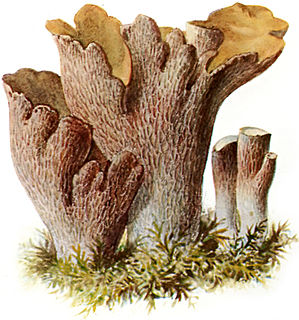
Climacodon is a widespread genus of tooth fungi in the family Phanerochaetaceae.

Mycena adscendens, commonly known as the frosty bonnet, is a species of fungus in the family Mycenaceae. The fungus produces small white fruit bodies (mushrooms) with caps up to 7.5 mm (0.3 in) in diameter that appear to be dusted with sugar-like granules. Caps are supported by thin, hollow stems up to 20 mm (0.8 in) long, which are set on a disc-like base. It is distributed in the United States, where it has been found from Washington to California, Europe, and Turkey. The fruit bodies grow on fallen twigs and other woody debris on the forest floor, including fallen hazel nuts. The variety carpophila is known from Japan. There are several small white Mycena species that are similar in appearance to M. adscendens, some of which can be reliably distinguished only by examining microscopic characteristics.
Cynema is a genus of fungi in the Tricholomataceae family. This is a monotypic genus, containing the single species Cynema alutacea, found in Papua New Guinea.

Mycorrhaphium is a genus of fungi in the family Steccherinaceae. The genus was circumscribed by Dutch mycologist Rudolph Arnold Maas Geesteranus in 1962. The type species is Mycorrhaphium adustum. Fruit bodies of species in the genus have caps, stipes, and a hydnoid (tooth-like) hymenophore. There is a dimitic hyphal system, where the skeletal hyphae are found only in the tissue of the "teeth", and a lack of cystidia. The spores are smooth, hyaline (translucent), and inamyloid.

The hydnoid fungi are a group of fungi in the Basidiomycota with basidiocarps producing spores on pendant, tooth-like or spine-like projections. They are colloquially called tooth fungi. Originally such fungi were referred to the genus Hydnum, but it is now known that not all hydnoid species are closely related.
Auriscalpium umbella is a species of fungus in the family Auriscalpiaceae of the Russulales order. Described by the Dutch mycologist Rudolph Arnold Maas Geesteranus in 1971, it is known from New Zealand.
Nothomitra is a genus of fungi in the earth tongue family Geoglossaceae. There is no known common name. Nothomitra is morphologically distinguished from Microglossum in that the fertile hymenium in Nothomitra is not flattened as in Microglossum. Furthermore, the hymenium in Nothomitra is distinctly free at the junction of the stipe, unlike in Microglossum in which the hymenium is flattened and gradually intergrades with the stipe.

Sarcoleotia is a genus of fungi in the earth tongue family Geoglossaceae. There is no known common name.
Hydnellum fraudulentum is a tooth fungus in the family Bankeraceae. Found in Australia, it was described as new to science in 1971 by Dutch mycologist Rudolph Arnold Maas Geesteranus from collections made in Victoria.
Hydnellum papuanum is a tooth fungus in the family Bankeraceae. Found in Papua New Guinea, it was described as new to science in 1971 by Dutch mycologist Rudolph Arnold Maas Geesteranus.
Hydnellum staurastrum is a tooth fungus in the family Bankeraceae. Found in Malaysia, it was described as new to science in 1971 by Dutch mycologist Rudolph Arnold Maas Geesteranus.
Hydnellum crustulinum is a tooth fungus in the family Bankeraceae. Found in Punjab, India, it was described as new to science in 1971 by Dutch mycologist Rudolph Arnold Maas Geesteranus.
Phellodon rufipes is a species of tooth fungus in the family Bankeraceae. It was described as new to science in 1971 by Dutch mycologist Rudolph Arnold Maas Geesteranus, from collections made in Japan.

Sarcodon fuligineoviolaceus is a species of tooth fungus in the family Bankeraceae. It was originally described in 1874 by Hungarian mycologist Károly Kalchbrenner as Hydnum fuligineoviolaceum, in Elias Fries's work Hymenomycetes europaei. Narcisse Théophile Patouillard transferred it to the genus Sarcodon in 1900. Sarcodon talpa, published by Rudolph Arnold Maas Geesteranus in 1967, is a synonym.
Sarcodon conchyliatus is a species of tooth fungus in the family Bankeraceae. Found in Malaysia, it was described as new to science in 1971 by Dutch mycologist Rudolph Arnold Maas Geesteranus. The fruit bodies have finely tomentose caps that are dull ochraceous, greyish or brownish, and typically have drab to purplish tinges. The spines on the cap underside are not decurrent on the stipe. Maas Geesteranus placed the fungus in the section Virescentes, along with S. atroviridis and S. thwaitesii, all species with flesh that dries to a deep olive green color.
Sarcodon humilis is a species of tooth fungus in the family Bankeraceae. Found in Malaysia, it was described as new to science in 1971 by Dutch mycologist Rudolph Arnold Maas Geesteranus.
Sarcodon wrightii is a species of tooth fungus in the family Bankeraceae. It was first described in 1860 by Miles Berkeley and Moses Ashley Curtis as Hydnum wrightii. They were sent a specimen collected from Japan as part of the North Pacific Exploring and Surveying Expedition (1853–56). Rudolph Arnold Maas Geesteranus transferred it to the genus Sarcodon in 1967. The fungus produces roughly spherical spores that are tuberculate and measure 5.5–6.5 by 4.5–5.5 μm.

Sarcodon thwaitesii is a species of tooth fungus in the family Bankeraceae. It is found in Asia, Europe, and New Zealand, where it fruits on the ground in mixed forest.
Mycorrhaphium stereoides is a species of tooth fungus in the family Steccherinaceae. The fungus was first described by Mordecai Cubitt Cooke in 1892 as Hydnum stereoides. The original specimens were collected in Perak, Malaysia, where they were found growing on a tree trunk. Rudolph Arnold Maas Geesteranus transferred it to the genus Mycorrhaphium in 1971.
Climacodon sanguineus is a rare species of tooth fungus in the family Meruliaceae that is found in Africa.







